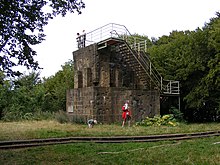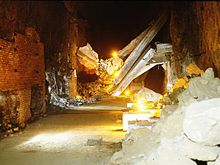Jakobsberg (Porta Westfalica)
| Jakobsberg | ||
|---|---|---|
|
View from the north from the east bank of the Weser near Minden over the Weser bridge of the B 65 to Jakobsberg |
||
| height | 235.2 m above sea level NHN | |
| location | at Porta Westfalica ; District of Minden-Lübbecke , North Rhine-Westphalia ( Germany ) | |
| Mountains | Weser Mountains | |
| Coordinates | 52 ° 14 ′ 31 ″ N , 8 ° 56 ′ 10 ″ E | |
|
|
||
| particularities |
|
|
The Jakobsberg is 235.2 m above sea level. NHN higher and at the same time the westernmost mountain of the Weser Mountains and thus the eastern boundary of the Porta Westfalica breakthrough in the North Rhine-Westphalian district of Minden-Lübbecke ( Germany ).
The mountain is the location of the Jakobsberg telecommunications tower , which stands in the place of the former Bismarck tower Porta Westfalica , the Schlageter monument and the Porta pulpit ; The Bismarckburg restaurant used to stand on it . His name has been in use since 1788, when a Prussian customs officer named Jakob was growing wine on the southern slope of the mountain .
geography
location
The Jakobsberg rises on the western edge of the Weser Mountains in the nature and geopark TERRA.vita . It is located directly northwest of the city of Porta Westfalica with the Hausberge district there and about 6 km south of the city of Minden , located at the Minden waterway intersection . The mountain is located directly to the east of Porta Westfalica, the Weser breakthrough, which lies on the northern edge of the Weser Uplands and the southern edge of the North German Plain and through which the Weser flows into the lowlands when coming from the mountainous region. The Wittekindsberg ( 294.2 m ) to the west , which is the easternmost mountain of the Wiehengebirge , is the western boundary of this breakthrough valley.
Natural allocation
The Jakobsberg belongs to the natural spatial main unit group Weser-Leine-Bergland (No. 37), in the main unit Calenberger Bergland (378) and in the subunit Weserberge (378.1) to the natural area Weser Mountains (378.10). Its landscape falls into the natural areas Weser-Aue (583.10) in the north-west and Lahder Terrasse (583.11) in the north, which in the main unit group Dümmer-Geestniederung (No. 58) and in the main unit Mittelweser (583) to the sub-unit Upper Middle Weser (583.1 ) counting. In addition, it falls in the main unit group Upper Weserbergland (No. 36), in the main unit Rinteln-Hamelner Weserland (366) and in the subunit Wesertal (366.0) in the natural area Rhemer Talweitung (366.00) in the south as well as in the subunit southern Wesergebirgsvorland (366.1 ) to the natural area of Hausberger Hügel- und Bergland (366.10) in the south.
Protected areas
Part of the Weser and Wiehengebirge landscape protection area ( CDDA no. 555552728; designated 1992; 15.2108 km² ) and parts of the fauna-flora-habitat area forests near Porta Westfalica (FFH no. 3719-301; 14.75 km²).
Towers
Bismarck tower Porta Westfalica
In addition to the highest point of the Jakobsberg ( 235.2 m ) height, the Bismarck tower Porta Westfalica ( ⊙ ) was built by Bismarck fans in 1902 to commemorate the Reich Chancellor Otto von Bismarck (1815–1898) . The tower was made of sandstone blocks, was 22.5 m high and was operated by the Bismarck League. On its 50th anniversary (1952) it was demolished to make way for the first telecommunications tower on Jakobsberg. The sandstone blocks of the Bismarck Tower were used to rebuild the old town hall of Minden, which was destroyed in the Second World War .
Telecommunications towers
Old telecommunications tower
In place of the aforementioned Bismarcktower Porta Westfalica also in 1952 Bismarcktower called telecommunications tower in reinforced concrete construction built with 40 m shaft height. The Deutsche Bundespost , which bought the land required for this tower from the Bismarck Federation, was contractually obliged as the builder of the telecommunications tower to set up a Bismarck memorial and a public viewing platform on the new tower .
Telecommunication tower Jakobsberg
In place of the former “Bismarck Tower” telecommunications tower, the Jakobsberg telecommunications tower (popularly known as Langer Jakob ), also made of reinforced concrete, was built from 1974 to 1978 , a 142 m high telecommunications tower ( type tower ).
Once again, the Deutsche Bundespost, as the builder of the telecommunications tower, was contractually obliged to set up a Bismarck memorial and a viewing platform on the new tower. The tower is now operated by Deutsche Telekom AG .
At 50 m height of the telecommunications tower Jakob Berg has an operating room and 23.26 m an open to the public observation deck, you can enjoy a good all-round visibility from, for example, parts of Weserbergland and North German Plain and the Kaiser Wilhelm Memorial on the Wittekindsberg.
Telecommunications tower Jakobsberg viewed from Hausberge
Bismarckburg restaurant
A few meters west of the Jakobsberg telecommunications tower was the traditional Bismarckburg restaurant , which was built at the end of the 18th century and, in addition to a falconry, was a popular excursion destination for the surrounding area. Over time, it was adapted to the new conditions in several modifications. After a long vacancy, the dilapidated restaurant was demolished in November 2013.
Schlageter monument
The remains of the Schlageter monument are located on the ridge line of the Jakobsberg in a south-west direction or just 650 m (as the crow flies) west of the Jakobsberg telecommunications tower at a height of 216.5 m .
The monument was erected in 1933/1934 based on a design by the Minden architect Hans Korth (1886–1949), but was not completely completed. A block-like base made of Porta sandstone carried a large steel cross - based on the Schlageter memorial in Düsseldorf by Clemens Holzmeister , which was highly regarded at the time - but which was undesirable as a Christian symbol for a National Socialist memorial. The cross was therefore moved to the north cemetery in Minden after a short time and integrated there into a memorial for those who fell in the First World War (1914-1918).
In 1958 the city administration of Porta Westfalica had a viewing platform built on the preserved monument base, which allows a wide view to the south and west, for example the view of the Kaiser Wilhelm monument on the Wittekindsberg.

Porta pulpit
The Porta pulpit ( 188.6 m ) is located about 150 m northwest of the Schlageter monument on the western slope of the Jakobsberg above a rocky cliff that drops steeply to the southwest.
In 1887, the cliff was made accessible as a porta pulpit by members of the Hausberge beautification association at the time . From there you have a good view of the Kaiser Wilhelm monument on the Wittekindsberg and the Weser in the Porta Westfalica breakthrough valley.
Military use
Underground production facilities
In the final phase of the Second World War, most likely in March 1944, the Philips company from the Netherlands moved the tube production to Jakobsberg. For this purpose, abandoned mine tunnels from the former iron ore mining were expanded. Such tunnels run through considerable parts of the Wiehen and Weser Mountains, the entrances are now usually walled up and made unrecognizable. In Hausberge and Barkhausen there were satellite camps of the Neuengamme concentration camp with over a thousand prisoners, a considerable number of whom worked in Jakobsberg. However, women from the area were also active in the mountain under significantly better conditions. At that time, the unfinished Dachs I underground relocation was also located in a tunnel in the mountain . The aim of this project was to set up an underground oil refinery for Deurag-Nerag , for which prisoners from the Porta Westfalica satellite camp were used.
After the end of the war, the local population used their knowledge of the tunnel system that ran through the mountains to remove material for the production facilities from the mountain and exchange it on the black market. The British occupying forces put an end to the hustle and bustle with a blast, which still dropped pictures from the walls 15 kilometers away, and formed part of what is now the river-side front of the Jakobsberg.
Site practice area
At the northern areas of the Jakobsbergs (district Lerbeck which is located) training area Minden-Bückeburg, Blue Lake of the Bundeswehr .
Transport links
The federal highways 61 , 65 and 482 cross near the Wittekindsberg , via which there is a connection to the federal motorways 2 and 30 , which run not far to the south and whose side streets can be used to get to the mountain through the Hausberge district, for example .
In addition, Jakobsberg is connected to the Deutsche Bahn railway network and can be reached from there through Porta train station , which belongs to the city of Porta Westfalica and is located at the western foot of the mountain on the eastern bank of the Weser .
The Jakobsberg is accessible by a good network of hiking trails, which also includes the European long-distance hiking trail E 11 and the Bückeberge-Weg and through which the sights on the mountain can be reached.
Individual evidence
- ↑ a b c d e Topographical Information Management, Cologne District Government, Department GEObasis NRW ( information )
- ↑ Map services of the Federal Agency for Nature Conservation ( information )
- ↑ End of an eyesore - excavator tears down "Bismarckburg". November 18, 2013, accessed November 30, 2013 .
- ↑ International Tracing Service HQ. Catalog of Camps and Prisons in Germany and German-occupied Territories. Arolsen, April 1950
- ↑ A Polish prisoner described the work in Jakobsberg in detail: Wiesław Kielar: Anus Mundi. Kraków 1972. The arrival from Auschwitz in Porta Westfalica can be found in Chapter XCVII.
Web links
- Telecommunication tower Jakobsberg. In: Structurae
- The underground war (at Porta Westfalica), on porta.bergmann82







